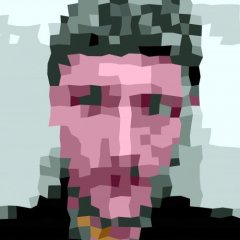82,718 Characters to Go
This week I finished reading the Holy Bible in Chinese. The version that I read (新译本) contains 1,055,606 Chinese characters. I started it several years ago, and finished the last third of the book (some 315,144 characters) this year.
The Bible is an epic millennia-spanning multi-genre story about God and his people. In addition to God himself, its major themes include worship, law and commandment, righteousness and wickedness, love, obedience and faithfulness, judgement, death and resurrection, covenant, conquest, sacrifice, salvation, social order, war, mission, hope, and more. The Bible’s genres include long theological histories of Israel and the Christian church, letters of exhortation and rebuke, philosophical writings, prophecies, proverbs, and songs.
The narrative sweep of the Bible is considerable. It covers the creation of the world, the rise and fall of its kingdoms, the end of all things. Its narrative structure is cyclical and complex. Certain events, figures, and themes in the narrative are recapitulated again and again, in different places and under different names and circumstances. The Bible contains perhaps the most surprising third act ever written. After the people of God are judged for their idolatry and cast into exile, and the remnant are waiting in eschatological anticipation of a promised king, the object of worship and apparent author of the text itself comes into the narrative in a new and unexpected way that transfigures everything that has happened in the story up to that point, and will happen after.
The Bible is an impressive and powerful book. I recommend it. The 新译本 is one of the more accessible Chinese translations out there. Unfortunately, it is stylistically flat. (Its closest English equivalent is probably the NIV.) The 和合本 is more literal, literary, and majestic by comparison. Translated early in the 20th century, the 和合本 remains the most popular Chinese translation of the Bible today (by far), although its language is older and more difficult.
Finishing the Bible puts me within striking distance of my 1,000,000-character goal for the year. Currently I am reading a collection of short stories by 老舍. I expect to complete that book—and my New Year’s Resolution—in the next couple weeks.
Link to《圣经》(新译本)
http://www.godcom.net/xinyiben/index.htm
Some statistics:
Characters read this year: 917,282
Characters left to read this year: 82,718
Percent of goal completed: 91.7%
List of things read:
《三八节有感》by 丁玲 (2,370 characters)
《我在霞村的时候》by 丁玲 (10,754 characters)
《在延安文艺座谈会上的讲话》by 毛泽东 (18,276 characters)
《自杀日记》by 丁玲 (4,567 characters)
《我没有自己的名字》by 余华 (8,416 characters)
《手》by 萧红 (7,477 characters)
《牛》by 沈从文 (8,097 characters)
《彭德怀速写》by 丁玲 (693 characters)
《我怎样飞向了自由的天地》by 丁玲 (2,176 characters)
《IBM Cloud文档:Personality Insights》 by IBM (25,098 characters)
《夜》by 丁玲 (4,218 characters)
《虎雏》by 沈从文 (46,945 characters)
《在巴黎大戏院》 by 施蛰存 (6,181 characters)
《分析Sonny Stitt即兴与演奏特点——以专辑《Only the Blues》中曲目 《Blues for Bags》为例》 (5,483 characters)
《一个女剧院的生活》 by 沈从文 (61,154 characters)
《致银河》 by 王小波 (17,715 characters)
《在细雨中呼喊》 by 余华 (132,769 characters)
《熊猫》 by 棉棉 (53,129 characters)
《1988:我想和这个世界谈谈》 by 韩寒 (81,547 characters)
《偶然事件》 by 余华 (20,226 characters)
《第七天》 by 余华 (84,847 characters)
《圣经》 (新译本) (1,055,606 characters; 315,144 read in 2019)



7 Comments
Recommended Comments